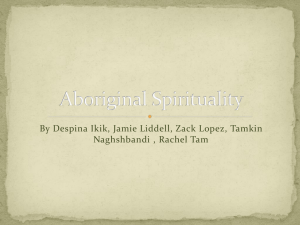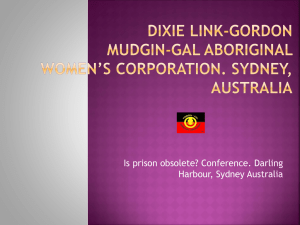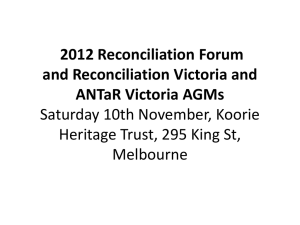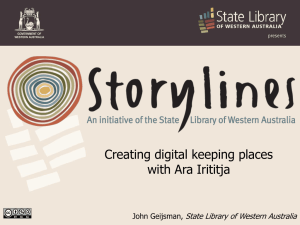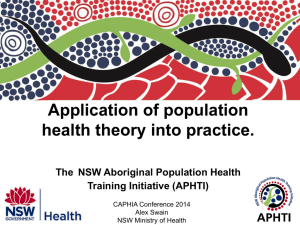Aboriginal Justice Strategy: 2011-12 Action Plan
advertisement
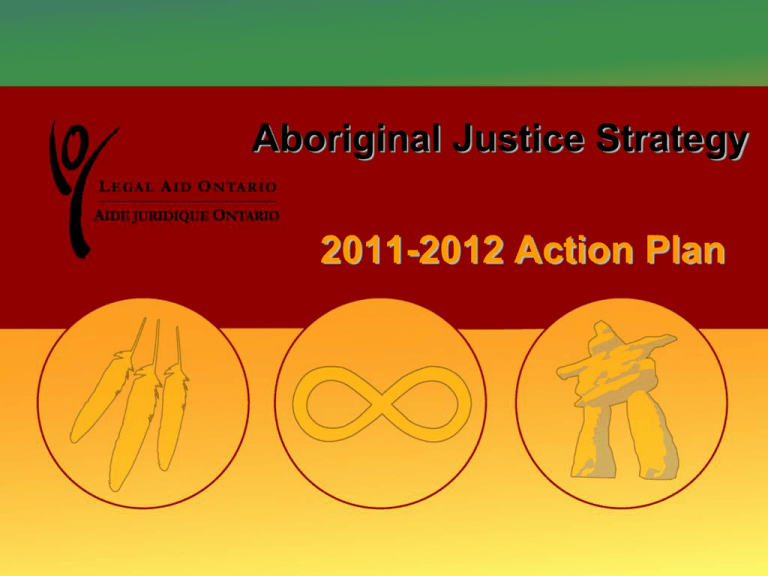
Aboriginal Justice Strategy 2011-2012 Action Plan The mandate of LAO’s Aboriginal Justice Strategy (AJS) is to establish a plan to achieve measurable improvements in service to Aboriginal People. Service issues identified by stakeholders and discussed in detail in the 2008 AJS development paper fit into four overarching areas: 1 Barriers to accessing justice 2 Lack of Aboriginal representation within LAO and LAO’s Advisory Systems 3 Lack of Aboriginal legal representation or legal representation that is appropriately informed on the unique needs of Aboriginal clients 4 Improving service on Aboriginal specific legal issues and addressing the role of LAO in participating or supporting Aboriginal specific or driven processes Legal Aid Ontario 2 • The 2008-2009 Action Plan included 12 initiatives focused on building awareness, relationships and a knowledge base within LAO. • The 2009-2010 Action Plan included 8 initiatives that focused on building the capacity of LAO’s service providers and giving them more resources, training and knowledge. • The 2010-2011 Action Plan included 4 initiatives that focused on adding sustainability and solidifying relationships and connections with Aboriginal stakeholders and service providers. Legal Aid Ontario 3 Highlights of the Aboriginal Justice Strategy • Implementation of the Gladue panel for criminal lawyers wishing to acknowledge criminal certificates for Aboriginal clients. This means that lawyers now have to meet specific standards in order to represent Aboriginal clients. • Block fees introduced through the Gladue enhancement program. This ensures that counsel have sufficient hours to prepare and make Gladue submissions and therefore are properly representing their Aboriginal clients. • Over 500 LAO staff have attended Aboriginal Cultural Competency Training. Legal Aid Ontario 4 Aboriginal Certificate Clients April 1, 2010 until March 31 2011: • LAO issued a total of 9,912 certificates to people who identified as Aboriginal, a total of 10% of all certificates issued in this time period: – 14% of LAO’s criminal certificates are being issued to Aboriginal clients – 15% of the certificates LAO issued for serious offences are for Aboriginal clients – 12% of LAO’s criminal certificates issued to youth are Aboriginal clients – 11% of any Child and Family Services Act (CFSA) related certificates are issued to Aboriginal clients • Aboriginal people only make up 2% of Ontario’s population. There are regional differences: Aboriginal people make up more than 55% of LAO’s clients in the Northern region and 4% in the GTA. • The fact that LAO knows who and where Aboriginal clients are is invaluable for decision-making and priority setting. Legal Aid Ontario 5 THE 2011/2012 ACTION PLAN The 2011-2012 Action Plan includes 8 proposed initiatives focusing on defining LAO’s role in providing sustainable long-term funding and services that address the unique legal rights and needs of Aboriginal individuals, communities, stakeholders and service providers. Legal Aid Ontario 6 1. Building a sustainable long-term funding plan for Aboriginal Justice programs 2. Evaluation, review and agreement with Nishnawbe-Aski Legal Services Corporation 3. Outreach and communication strategy 4. Aboriginal recruitment and mentorship plan 5. Regional assessment plan 6. AJS clinic initiative 7. Sustainable long-term cultural training program 8. Aboriginal child protection plan Legal Aid Ontario 7 Building Sustainable Funding Plan • In 1999, LAO dedicated money to fund innovative service projects. The Innovations Fund, the Aboriginal Fund, and the Victims of Violence Fund were set up as time-limited funding for special programs that promoted access to justice. • Specifically, the Aboriginal Fund provided funding to Aboriginal Legal Services of Toronto’s Gladue Caseworker Program and the Ontario Federation of Indian Friendship Centres’ Community Justice Program. The Department of Justice Canada and the Ministry of the Attorney General also supported both programs and after an evaluation the three sponsors have continued to provide funding. • A plan will be developed to continue funding successful initiatives on a long-term basis and to move away from short-term contracts. Legal Aid Ontario 8 Evaluation, Review & Agreement with Nishnawbe-Aski Legal Services Corporation • The current Memorandum of Understanding between LAO and NALSC has expired, although it is still in effect pursuant to the duration clause. • It is recommended that an evaluation, review and consultation take place prior to entering into a new agreement with NALSC. • This evaluation will guide the form and content of any new agreement between LAO and NALSC to provide LAO services to Nishnawbe-Aski Nation clients. • This project will take approximately 18 months. Legal Aid Ontario 9 Outreach & Communication Strategy Goals: • Ensure there is communication and outreach between LAO and Aboriginal communities on a local, regional and provincial level. • Ensure sensitive and thoughtful consideration is given when assisting Aboriginal clients. • Ensure barriers have not been created and that resources are accessible in various formats and forums that address the unique needs of Aboriginal communities. Legal Aid Ontario 10 Aboriginal Recruitment and Mentorship Plan Goals: • Continue the development of a recruitment policy aimed at hiring Aboriginal staff through the Lawyer Workforce Strategy and other LAO Human Resources initiatives. • Include an Aboriginal component to the Criminal Lawyers’ Association/Legal Aid Ontario Mentorship Program. • Provide accessible technology-based tools that will allow lawyers across Ontario to access the Mentorship Program. • This will also allow lawyers who represent Aboriginal clients to provide specific knowledge to others and will result in improved legal services to Aboriginal clients and communities Legal Aid Ontario 11 AJS Clinic Initiative • During the 2009/2010 clinic funding application process, gaps in knowledge and awareness of Aboriginal clients’ needs became apparent. • LAO has made it a priority to improve legal aid services to Aboriginal individuals and communities, and expects that clinics will aim to improve their services as well. • It is recommended that LAO work with individual clinics, groups of clinics and the Association of Community Legal Clinics of Ontario (ACLCO) to draw up a plan to improve poverty law services to meet the unique needs of the Aboriginal community they serve. • LAO will also work with clinics and the ACLCO to identify their Aboriginal community’s needs and the best way to improve services. Legal Aid Ontario 12 Regional Assessment Plan • In the AJS development paper and the 2008/09 Action Plan, LAO adopted a policy defining Aboriginal services as a priority by incorporating the Action Plan into the performance contracts of executive and managerial staff. • Due to the evolving nature of the AJS, it is important that LAO and each of its Regions incorporate Action Plan initiatives into their performance contracts annually. • In order to ensure that Aboriginal initiatives are being made a priority it is expected that the Regions are aiming to improve their services as well. • It is recommended that each Region work to identify what their Aboriginal communities’ needs are and draw up a plan to improve their services to meet those needs. Legal Aid Ontario 13 Long-term Cultural Training Program • Delivery of training that reflects LAO’s mandate of providing quality legal aid services to low-income Aboriginal individuals and communities. • Currently over 500 LAO staff have attended Aboriginal Cultural Competency Training. • Continued training of new staff and ongoing training of current staff should take place that is accessible, cost effective and includes the use of technology and innovative approaches that are accessible to a wide range of individuals. Legal Aid Ontario 14 Aboriginal Child Protection Plan • During the 2008/2009 AJS consultations, one of the most commonly heard issues from Aboriginal communities and stakeholders was the lack of public legal education on Child Protection rights. • Currently there are more Aboriginal children in care right now than at the height of the residential school system. • 11 per cent of LAO’s Child and Family Services Act related certificates are issued to Aboriginal clients. Aboriginal children represent 22 per cent of Ontario Crown wards. • Written, web based and public outreach on Child Protection will allow Aboriginal individuals and communities to know their rights and provide accessible and culturally sensitive information that promotes access to justice. Legal Aid Ontario 15

